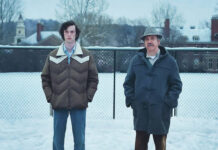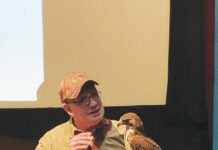It’s been 40 years since a movie about a great white shark sent swimmers scampering for shore. To celebrate the anniversary of “Jaws,” I indulged in my own version of Shark Week that including watching Steven Spielberg’s classic film for the umpteenth time and finally getting around to reading the novel by Peter Benchley that inspired it. To round out my Jawsathon, I also read Carl Gottlieb’s highly entertaining memoir, “The Jaws Log,” that documents the making of the film.
I fully expected, as is almost always the case, that I would like the book better than the film version, but boy, was I wrong. In all fairness, we have to remember that “Jaws” is Benchley’s first novel, and he hasn’t quite mastered the intricacies of characterization and plotting. This is not to say that “Jaws” is a bad book. Lurking beneath the surface is a very scary shark, and Benchley shines when it comes to describing the shark’s perspective and behavior. The main problem with the human characters is that none of them are very likeable, and we end up rooting for the shark.
Part I of the story, like the film, begins swimmingly enough with the shark attacks that result in gruesome deaths. As someone who spent his summers as a boy on Nantucket, Buckley clearly understands the resultant conflict between Chief Martin Brody and Larry Vaughn, Amity’s mayor. Brody wants to close the beaches until the shark goes away or is killed, while Vaughn needs to keep them open in order to attract the summer tourist trade so vital to his town’s economy.
However, the two subplots introduced in Part II just suck the air out of the novel’s momentum. One features Brody’s wife, Ellen, who seeks to liven up her boring life by having a one-afternoon stand with Matt Hooper, the young marine biologist who has arrived to study the shark. Turns out, Ellen once dated Hooper’s older brother back in days when they all spent their summers in Amity, and Hooper has always been attracted to her. This joyless little interlude only serves to make the reader dislike both lovebirds. The second subplot concerns the mayor’s shady real estate dealings with the mafia. He’s in hock to them up to his ears, and this puts added pressure on him to suppress the story of the shark attacks in order to keep real estate prices from tanking. After devoting more than 100 pages to these unnecessary distractions, Benchley finally gets back on track in Part III, as Brody and Hooper joint forces with the irascible fisherman, Quint, and struggle to do in the shark. I don’t want to spoil the ending for you, but let’s just say, even though the shark dies, it’s disappointing, since it lacks the film’s exciting Hollywood ending.
Of course, it’s impossible not to compare the novel with its screen version, and when I did, I was filled with admiration for both its director and the writers who refashioned Benchley’s original attempt at the screenplay into a story that works on all levels. The decision to deep-six the subplots and focus on the main story line was very smart. Likewise, Spielberg’s genius comes into play as he works with a stellar cast to create characters we care about. The enhancement of Quint’s motivation for his Ahab-like vendetta against Jaws, via the unforgettable Indianapolis monologue, is nothing short of brilliant. When you consider that Spielberg was only 27 when he made “Jaws,” and the problems involved in the production, the transformation of a so-so book into an unforgettable film that still holds up after 40 years is nothing short of miraculous.
Speaking of problems on the set and behind the scenes, Carl Gottlieb was privy to all of them, and his insider look at the ingenious ways they were solved during the making of “Jaws” is one of the reasons I enjoyed “The Jaws Log” so much. No one is more qualified to write this memoir, since Gottlieb was not only one of the principal screenwriters, but also acted in the film, playing the role of Harry Meadows, editor of Amity Island’s newspaper. An ironic aside: Meadows had a much larger role in the book, but Gottlieb cut his own character’s appearances down to two short scenes in the film in the interest of creating a tighter script.
Another reason to recommend “The Jaws Log” is that Gottlieb can write. He’s funny, gossipy, and above all very adept at explaining the convoluted process of filmmaking. His little book could serve as a text for anyone who wants to make a movie. Gottlieb makes us remember that “Jaws” was made back in the days before computer-generated images, and his stories about the struggle to get “Bruce,” the shark, to not only look terrifyingly real, but also function in the water, along with tales of the actors’ and locals’ shenanigans, and the company’s battles with water and weather are wonderful.
Our outsider’s interest in the process that brought “Jaws” to life in all its terrifying glory is comparable, I think, to our fascination, as readers, with stories about great white whales and great white sharks alike. As land animals, we know that when we venture into the alien element of the ocean, we do so at our peril. And no, it will never be truly safe to go back in the water.




